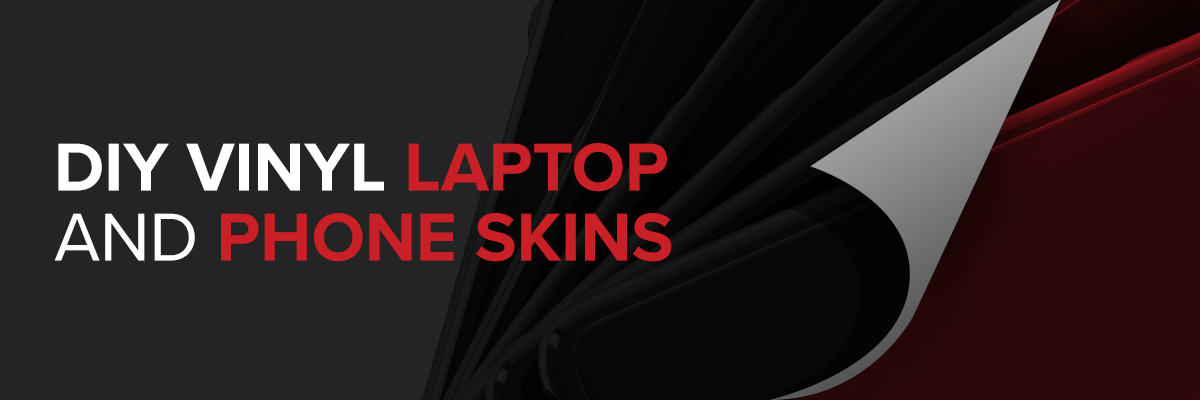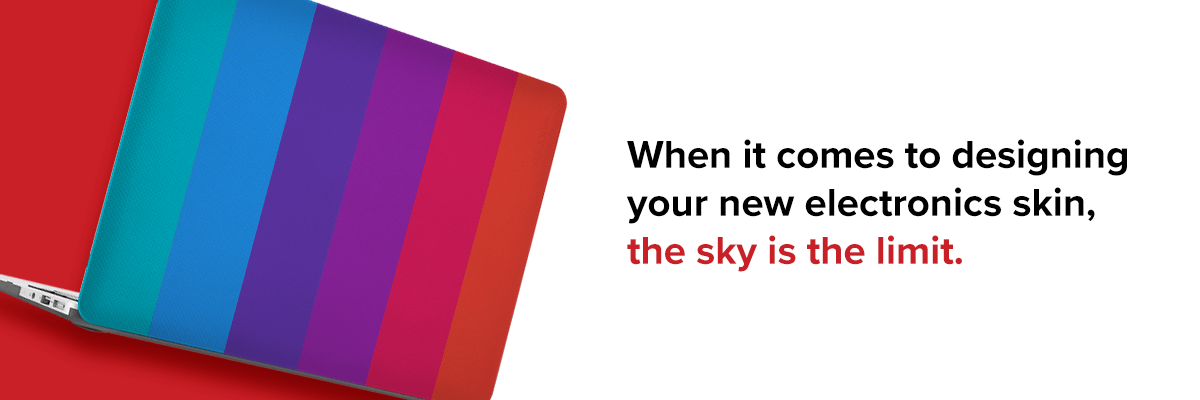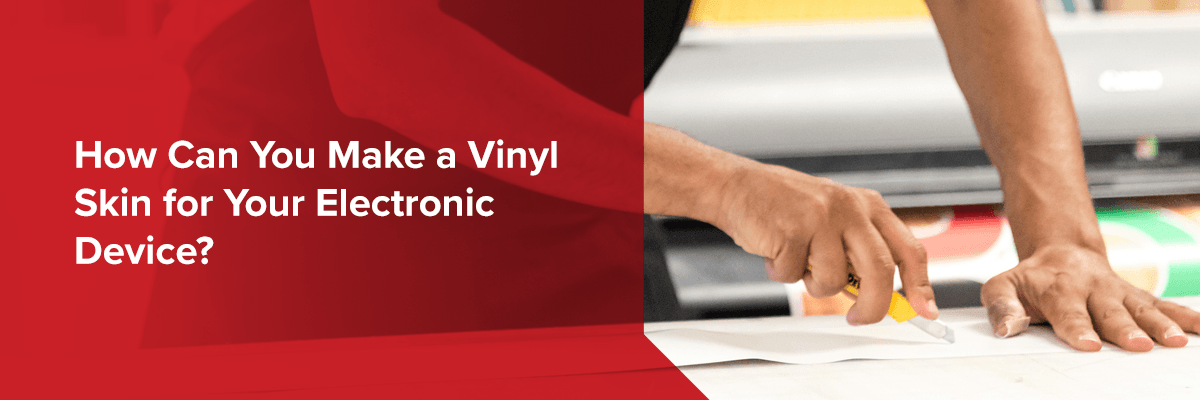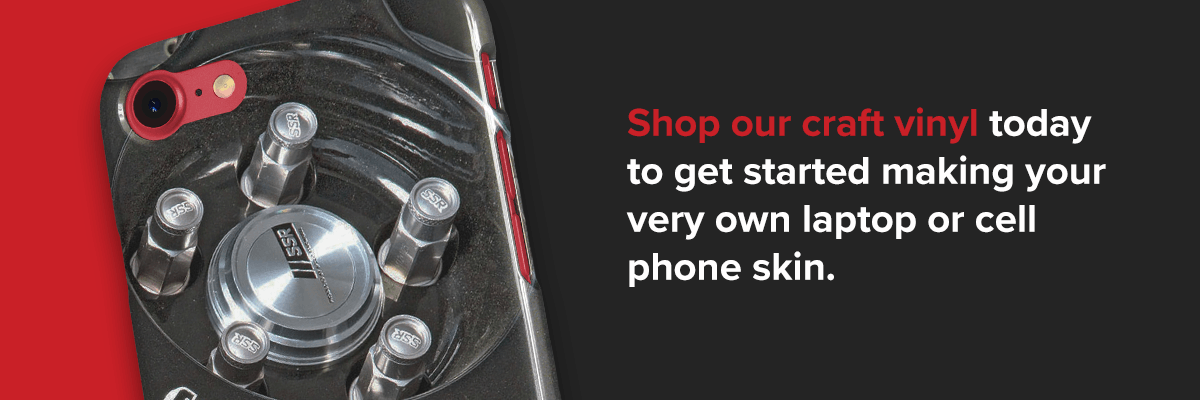
DIY Vinyl Laptop and Phone Skins
Ever wished your laptop or phone was just a bit more personal? Because let’s face it — while your laptop and phone are probably among your handiest and most frequently used devices, they aren’t always fashionable or fun-looking. Most of these electronics come in a plain black, white or silver that’s functional and sleek, but not exactly personal. Even if you spring for the rose-gold phone or the fancy gold-colored laptop, it’s still just one plain color. What if you feel like a change? What if you want a pattern or design?
There are a couple of solutions. For some people, pre-made phone cases or laptop skins are the right answer. But you’re still stuck with a pattern, color or logo that someone else designed. What can you do if you're looking for something more personal and specific than you could never hope to find in stores?
In times like that, the best answer is usually to roll up your sleeves and make a vinyl laptop cover or cell phone cover yourself.
If you're concerned that something like this is beyond your skill level, or you've simply never tried this before, we’re here to help explain the process and get you started. Consider this your beginner’s guide to DIY vinyl laptop skins and cell phone skins.
What Are Vinyl Cell Phone and Laptop Skins?
A laptop or cell phone skin is essentially a decal that goes on top of your device, covering the surface and transforming it. It’s not a case but a large sticker that you can design yourself and cut to the exact size that will cover the top of your laptop or the back of your phone. In doing so, you give your device an entirely new appearance.
As the name suggests, you make these decals from vinyl that’s thin, flexible and adhesive. In this way, your new laptop or phone skin will add zero weight to your existing electronic device.
What Can You Make With a Vinyl Laptop or Cell Phone Skin?
When it comes to designing your new electronics skin, the sky is the limit. If you can imagine it, then you can create it and turn it into a skin. For your design, you can re-purpose photographs, whether they’re your own or something you’ve found somewhere else. You can draw something on paper and turn it into a decal, and you can even design your own pattern in digital painting programs.

Whether you want to use a solid color, the logo of your favorite sports team, a character from your favorite TV show, or a cute drawing your daughter did for you last week, it’s still the same easy process.
What Do You Need to Make Vinyl Skins?
Printing these vinyl laptop and cell phone skins is easier than you might think, and you need just a few simple supplies to do it:
- Your laptop or cell phone: After all, what is a vinyl decal without something to put it on?
- An image to print: Remember, this can be anything. A drawing, a painting, a photograph — whatever you can imagine. For the best results, the image should be high-quality with a resolution at least as high as that of your laptop screen.
- Printable vinyl: Ideally, this vinyl will be a self-sticking variety, where you’ll peel off a protective sheet to reveal the naturally sticky underside. For example, many 3M IJ180 Graphic Wrap Film, has an air-release adhesive feature that lets it easily stick to rounded or bumpy surfaces, making it a great choice for laptops and other electronics. Another great choice (but non-printable) is this ORACAL® 951 Premium Cast Film that's specifically designed for small objects such as cell phones. Both of these films come in a wide range of colors.
- Printer: A standard inkjet printer or a similar device will allow you to transfer your image from your computer to the vinyl.
- Laminate overlay: This will help provide a finishing touch and protective top layer over your vinyl decal.
- Applicator tool: An applicator tool will help you attach the vinyl. If you don’t have one of these, a credit card will work just as well.
- Scissors: These will help you trim off any extra edges and get the vinyl to the correct size.

How Can You Make a Vinyl Skin for Your Electronic Device?
Once you’ve gathered all these supplies, the next thing to do is start working on your very own DIY project. If you’re ready, then follow these steps to create your own customized laptop or cell phone skin.
1. Adjust the Image
First, you may need to give the image you’ve selected a little bit of touch-up work. If it’s a photograph, you may want to adjust the saturation or the sharpness of it, to make sure it’s as eye-catching and attractive as possible. This is especially true if it’s a photograph you’ve taken of a drawing or design that you’ve done by hand. Make sure the image is clear, not blurry, and stands out well.
Another edit you may need to make is to the size of your image itself. Make sure that it’s scaled correctly so that when it prints out, it will be the correct size to cover your laptop or phone. If your laptop is giant, you may need to split the image in two and join the pieces together on the surface of your laptop.
Use a ruler if necessary and figure out the exact dimensions you’ll need to cover. Feel free to take your time on this. It’s better to spend a little longer and get it right than to rush and get it wrong.
2. Cut Your Vinyl
Grab a sheet of your printable vinyl and carefully measure out the exact dimensions of a sheet of paper your printer will accept. Then, cut the vinyl to this precise size. If you’ve got an extremely steady hand, you can free-hand this with a pair of scissors. Otherwise, you may want to use a guillotine-style paper cutter or a rotary blade with a ruler.
It’s worth noting that many types of printable vinyl already come in the exact dimensions as a typical sheet of printer paper. If this is the case, then you will not have to worry about cutting at all, and can skip ahead to the next step.
3. Add the Protective Laminate
The protective laminate layer isn’t a requirement, but it can do wonders to protect your vinyl from scratching, fading, staining or even peeling. If you’ve decided to opt for this additional laminate vinyl layer, you’ll want to cut it into a piece the same size as your first vinyl sheet. Next, peel the backing off the laminate and carefully line it up exactly with the edges of the first vinyl sheet. Slowly and gently press the two together, and use your applicator tool or credit card to smooth them out and make sure no bubbles remain.
4. Print Your Design
Load your vinyl sheet — with the extra protective vinyl if you’ve decided to use it — into the printer, just as you would with an ordinary sheet of paper. Then, send your photograph or design to the printer, just like you would when printing any other document or photograph. The design should print out onto the vinyl without any hiccups.
Remember that if your design is split up over two different sheets of vinyl, you’ll need to prepare a second piece of vinyl and print the second half of the design as well.
5. Put the Vinyl on Your Laptop or Cell Phone
Now that you've printed your design, the only thing left is to apply it carefully onto the surface of your device. This is a delicate process, and you can do it in numerous different ways. We don’t recommend merely sticking the vinyl on with no preparation or technique. Instead, clean the surface of your device thoroughly then try one of these methods.
- Peel the backing off one end, lining this end carefully up with an edge of your device and smoothing the edge and corners into place. Then, continue to peel the backing off a little at a time, slowly rolling the vinyl down into place. By the time you reach the opposite end, the vinyl should be mostly adhered, and all that should be left to do is stick the last two corners into place.
- Alternatively, try taking a piece of tape and using it to connect one end of the vinyl to the end of your device, with the protective backing still in place. Then, begin at the opposite end of the device and start to peel the backing off a little bit at a time, working to smooth it into place as you go. By the time you reach the end with the tape, the vinyl should be neatly in place, and all that remains is to remove the tape and the rest of the backing and finish smoothing the decal down.
- Finally, if you’re feeling bold and have a friend around to help, you can enlist them to work with you. Between the two of you, you’ll have four hands to hold each of the four corners of the decal. Position the decal directly over your device, making sure it’s lined up directly where you want it. Then, touch the middle of the decal down first, smoothing out towards the edges from there in a way that pushes any bubbles out towards the edges.
After the decal is attached, remember to use your applicator tool to smooth it into place and help discourage bubbles from forming.
Why Are Vinyl Skins Such a Great DIY Project?
These vinyl laptop skins make such excellent DIY projects because of how easy they are. They don’t require very many supplies, and the supplies that they do need are fairly common things that you might already have on hand. Likely, the only thing that you would genuinely have to go out of your way to buy would be the vinyl itself.
Unlike some DIY projects which require years of skill and practice, these vinyl skins can be designed, printed and applied by anyone. They don’t need any prior skill or knowledge and can be made very quickly. This makes them one of the best DIY projects.
The Benefits of Vinyl Laptop and Cell Phone Decals
We’ve talked about what these skins are, what you need to make them, how to make them and more. The one thing we haven’t mentioned, however, is what makes them better than something like a traditional laptop sleeve or cell phone case. In other words, why should you go to all the trouble of making your own when you could buy something that serves the same purpose?

It’s simple.
1. They’re Inexpensive
Vinyl decals are incredibly inexpensive to make. As we mentioned before, the only material you may need to go out and buy is the vinyl itself, and if you’re a frequent vinyl crafter, you may not even have to buy that. Either way, the cost of the vinyl will almost always be far less than the price of whatever you might pay for a cell phone cover or similar product.
2. They’re Removable
Yes, a laptop sleeve is removable, too. But when you pull off a laptop case and throw it away, you’re also throwing away all the money you spent on that product. When you decide you’ve had enough of a laptop decal, you can peel it off and discard it without feeling that you’ve just wasted money.
3. They’re Customizable
Probably the most significant benefit you can get from DIY vinyl cell phone skins that you’ll miss from a pre-made cell phone case is the customizability. When you design your own skin, you can choose any image you want. You can use a picture of your vacation last year, or a picture of your best friend. You might use a drawing you made or a crayon scribble your toddler drew for you. There’s no limit to the designs you can choose.
When you go for the pre-made cases, however, you’re limited to whatever is available in the stores or online. And while some companies may allow customization, again, you’re running into the issue of higher prices. This easy DIY skin allows you that same customizability at a fraction of the cost.
Shop Craft Vinyl Today
Do you have a laptop or cell phone that’s in need of a makeover? Are you tired of the blank neutrals and looking for a serious style upgrade? The first step is to gather your materials. Once you’ve got your image or design selected and a reliable printer at the ready, the only thing you’ll need to purchase is some high-quality craft vinyl.

If you’re looking to buy the vinyl you’ll need for your project, then you’ll want to stop by Rvinyl. We sell craft vinyl in more than 100 different colors and finishes, allowing you the customization options you need to bring your new laptop skin to life. And if you decide you want to place a bulk order to stock up for a whole collection of projects, we also offer free shipping on most orders.
Shop our craft vinyl today to get started making your very own laptop or cell phone skin.